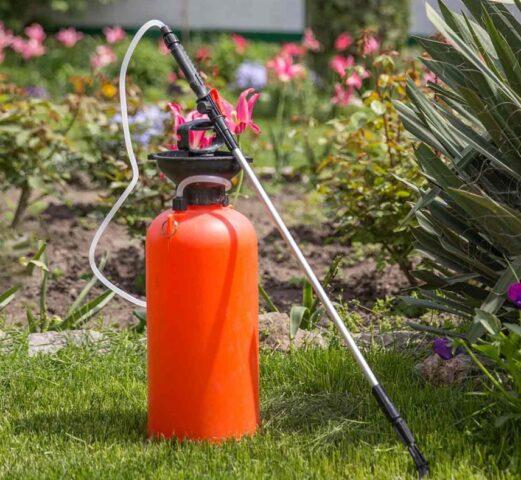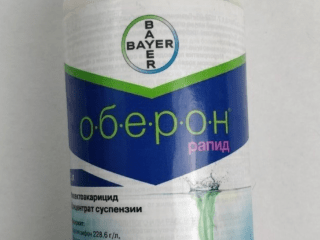Content
- 1 Composition and release form
- 2 Operating principle
- 3 Advantages and disadvantages
- 4 At what temperature can Gesagard be used?
- 5 Preparation of working solution
- 6 How to dilute Gesagard in 10 liters of water
- 7 Compatibility with other tools
- 8 Security measures
- 9 Analogues
- 10 Conclusion
- 11 Reviews of the drug Gesagard
Gesagard herbicide is a new generation drug that has a wide range of applications, capable of quickly ridding fields, vineyards, meadows and garden beds of grass, as well as protecting them from all types of weeds. The product can be used for industrial and vegetable crops, potatoes, and herbs. Gesagard belongs to a new generation of soil herbicides, which, due to its high performance, is very popular among farms and ordinary summer residents.

The drug was manufactured by the Swiss company Syngenta
Composition and release form
Gesagard KS is a one-component herbicide, which was produced on the basis of a well-known drug, widely used in industry, an active substance from the chemical class of triazines - promentrin (50% concentration).Thanks to it, the product is characterized by a selective effect, namely, it has a negative effect on weeds and is not dangerous for cultivated plants. It is presented on sale in the form of a concentrated suspension in bottles of 100 and 300 ml, as well as in large volumes - canisters of 5 and 10 liters.
Operating principle
Gesagard is successfully used in the garden due to its broad principle of action. Its active components are capable of blocking the Hill reaction and also inhibiting photosynthesis, which stops the growth of weeds and eventually they die. The herbicide directs its selective effect on cereals and annual dicotyledonous weeds in the sowing of vegetables, potatoes and other plants.
A huge advantage of the product is that it does not harm crops; soil treated with Gesagard can be sown with any plants. The herbicide acts systemically, it gets inside the weed, spreads through its tissues and practically stops the process of photosynthesis. Within 2-4 days after spraying a vegetable plantation with a working solution, the weeds growing on it wither and die after half a month. New shoots do not form due to the fact that Gesagard abundantly wets the soil and affects the roots of the weed.
The area is treated with Gesagard herbicide by spraying. The soil is completely covered with the product, including the area between the beds. After the procedure, no work is carried out on the site for several days.

The herbicide is able to stop the growth of such difficult-to-grow grass as dodder
Advantages and disadvantages
Compared to many other pesticides, Gesagard has an extensive list of advantages.

The drug can be used not only before germination, but sometimes after germination
Advantages:
- long period of protection;
- wide spectrum of action;
- destruction of difficult to eradicate weeds;
- protection of industrial and vegetable crops;
- safety for plants;
- economical consumption;
- ease of use;
- possibility of combination;
- environmentally friendly;
- affordable price.
Flaws:
- performance at a certain temperature;
- long-term decomposition in soil;
- unsuitability for juicy fruits.
At what temperature can Gesagard be used?
According to experts, Gesagard is sensitive to temperature conditions. Since it contains sulfur, when used on cold days (below +15 ° C) the herbicide effect will be negligible. Also, the result cannot be achieved when used in hot weather, when the thermometer is above +30 ° C and the humidity is more than 50%.
The rest of the weather requirements are usual: the freshly prepared composition is used on a cloudy and windless day, in the morning or evening hours, the use of Gesagard for dew is allowed.
Preparation of working solution
To achieve the desired effect, the Gesagard herbicide solution, with which gardeners subsequently work, must be properly prepared. To do this, it should be taken into account that the water for the mixture is used as pure as possible, without impurities of minerals or clay. The sprayer is first filled with liquid to ½ part of the volume, after which the amount of herbicide that is recommended for treating the selected crop is added to it.Then the mixture is mixed well until its mass becomes homogeneous, and at the final stage, with continuous stirring, the remaining water is added to the container.

The prepared Gesagard solution must be used within 24 hours
How to dilute Gesagard in 10 liters of water
Depending on the composition of the soil and its contamination, Gesagard is used at different application rates. If the soil is light, then the product is taken in a minimum amount; if it is heavy, with a high concentration of humus, then the drug is diluted in the maximum amount. Before treatment, the area must be well watered.
Gesagard for potatoes
For potatoes, the herbicide is applied immediately after planting the crop or before its first shoots begin to appear. The treatment is carried out once, the result will be visible after three weeks. On peat soil, potato crops are sprayed when weeds appear.
For potatoes, use 75 ml of product per 10 liters of water. Consumption per hundred square meters is about 5 liters. Shake the mixture well before spraying.

For a month after applying the herbicide, potatoes are not loosened or treated with anything.
Gesagard for carrots
For carrots, Gesagard is used in a proportion of 45 ml per 10 liters of water. Treatment is carried out before sowing or in the presence of young shoots that have produced two true leaves. For 1 hectare of plantings, 2-3 liters of ready-made solution is enough. In this case, the protective period will be approximately three months.
Gesagard for dill and herbs
Gesagard can be used when growing basil, dill, parsley, and celery.It is used both on an industrial scale and in private plots. It is recommended to spray all herbs before sprouting at a dosage of about 3 kg/g.
Gesagard for legumes
When growing legumes, such as lentils, beans, vetch, peas, china, a herbicide is also used. For them, experts recommend using a solution in a concentration of 60 ml per bucket of water, except for peas, for which it is better to dilute 1/3 less Gesagard in the same amount of liquid and spray it immediately after sowing. The remaining varieties of crops are processed a couple of days before their emergence.

Herbicide consumption in fields with legumes is three liters per hectare
Gesagard for garlic
To process garlic, prepare a solution of 40 ml of Gesagard and 10 liters of water. The work is carried out immediately after sowing the crop. About 2 liters of product are used per hectare.
Gesagard on sunflower
The herbicide Gesagard is often used in sunflower fields. Their processing is carried out at the time of planting the crop or immediately after it. For 1 hectare of territory, 2-3 liters of the prepared solution are consumed.
Compatibility with other tools
Farmers often combine the herbicide Gesagard with other drugs of similar action. To determine the compatibility of products, you should first conduct a simple test. To do this, add Gesagard in a tank mixture to the water after the preparations, in the form of a wettable powder, but before the emulsion concentrate and aqueous solution.
To make the spectrum of action of the herbicide Gesagard even wider, as well as to enhance its effectiveness, the drug is combined with products based on phenaxoprop-P-ethyl and hisalofop-P-ethyl, for example: Furore Super or Targa Super. This mixture can destroy even perennial weeds.

Gesagard showed excellent results when used simultaneously with drugs with a weak acid or alkaline reaction
Security measures
Manufacturers of the herbicide Gesagard claim that the product does not cause the slightest harm to people. It has no specific odor and does not pose a danger to bees, mammals and water inhabitants. If you use the drug in the correct dosage, it is not phytotoxic, but it must be kept out of the reach of children.
Gezagrad should be stored in a dry, cool, dark room for a maximum of three years.
The drug is suitable for processing any crops, but it can impart a specific flavor to those that bear juicy fruits.
Analogues
The herbicide Gesagard has several analogues, which are also on the market and used by gardeners. Of these, the most commonly used products are Hurricane Forte, Lontrel, Fusilade Forte and Bazagran.
The main difference between these drugs is the active ingredients and, as a consequence, the range of application, consumption rate, registration on certain plants, as well as cost and manufacturer.

The greatest effectiveness of the herbicide is achieved when it is used no later than seven days after weed germination
Conclusion
Gesagard herbicide is used by both summer residents and owners of large subsidiary plots and farmers.The drug has shown high efficiency. It fights well against many difficult to remove weeds. You can find many positive reviews about it. The herbicide is praised for its convenient use, low price, and single use.
Reviews of the drug Gesagard
https://youtu.be/Jw1kls1hNDQ








